Arctic Silver 5 Review
Despite it's competitors, Arctic Silver 3 has been the
thermal paste of choice for most overclockers the last couple
of years. Still, Arctic Silver has not rested on their laurels,
and we are proud to present the world's first review of their
new baby - Arctic Silver 5.

Arctic Silver. A brand most overclockers associate with high
quality thermal paste, possibly the best available. Since they
first brought attention to the importance of good thermal paste
with their original Arctic Silver, they've given us a number
of different pastes. The last, and perhaps most successful, is
Arctic Silver 3 - AS3 for short.
This last year, however, things have changed. Shin Etsu has
become well established due to their G-751 paste, providing even
lower temperatures in some reviews.
Arctic Silver now answers the challenge by launching a new revision
of their Arctic Silver; Arctic Silver 5. Do you wonder what happened
to Arctic Silver 4? The explanation is as amusing as it
is unique: In Japan, which is a huge market for Arctic Silver,
the number 4 is associated with death. That is a real mood-killer
in marketing, particularly in relation to expensive hardware.
Therefore Arctic Silver plays leap-frog and skips the number "4".
One can observe the same thing in floor-numbering in the US,
where floor 13 is nowhere to be found. If you know your customers,
you know the market. Arctic Silver has placed a good QED
on that one. :)
Arctic Silver 5 will be released on October 20, 2003.
Editorial note: Arctic Silver has given us permission to
release this review, so there is no violation of NDA's. :)
The compound
The polysynthetic suspension fluid in Arctic Silver 5 is improved.
A new mix of non-silicone synthetic oils has proven more stable
than that of Arctic Silver 3, further improving the long-term
performance of Arctic Silver 5, especially under high-vibration
or other difficult conditions.
The average particle size is reduced to less than 0.45 microns
(<0.000018 inch). These microscopic, thermally conductive
particles in Arctic Silver 5 fill the voids between the core
and the heatsink more effectively than previously, to provide
improved thermal transfer.
The compound is more dense. The sizes of the individual filler
particles are designed so that the smaller particles better fill
the interstices between the larger particles than with our previous
compounds. While most thermal compounds contain 30% to 50% thermally
conductive filler by weight, Arctic Silver 5 contains almost
90%.
The application is easier. Like Ceramique, Arctic Silver 5
is not to be spread out on the P4 heat spreader. A small dab
of AS5 is placed on the center of the heat spreader, and the
pressure from the heatsink spreads it out to form an air-free
minimum bond line.
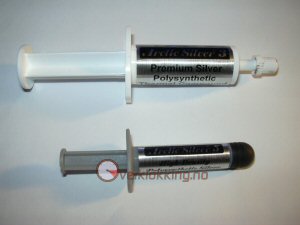
Arctic Silver 3 came in 6 gram syringes, but due to customer
request, Arctic Silver 5 comes in the same 3 gram syringes used
for Ceramique, except they are grey. For heavy duty overclockers
there are also 12 gram syringes available.
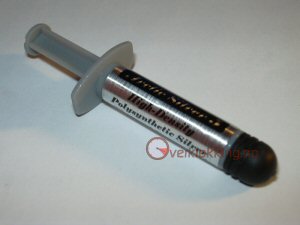
This is the new syringe Arctic Silver will use for all their
products as a part of a strategy to prevent plagiarism, which
most unfortunately has occurred (read more about this here).
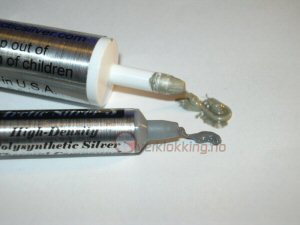
The color and viscosity is slightly changed. The AS5 is darker
than the AS3, and the viscosity is somewhat thicker, but witout
affecting the "spreadability" that much. The AS5 is still easy
to apply.
Test rig
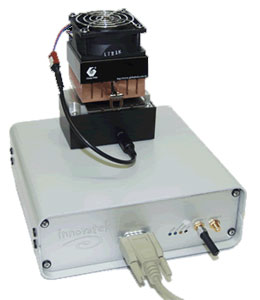 + + 
All tests were run the testbench we use for all our cooling
tests, the Innovatek KT-3 electronic thermal analyzer, coupled
with Vantec's VA4-C7040 cooler.
To make sure the thermal paste had "set" properly before any
tests were run, we let the test rig go for 3 days with 80 watt
load after applying a new thermal paste. Also, we ran all tests
twice, with a complete clean-down and reapplication of thermal
paste, to verify the results.
The test procedure is as follows:
- 40W load, 12V fan: 30 minutes
- 50W load, 12V fan: 30 minutes
- 60W load, 12V fan: 30 minutes
- 70W load, 12V fan: 30 minutes
- 80W load, 12V fan: 30 minutes
- 40W load, 7V fan: 30 minutes
- 80W load, 7V fan: 30 minutes
All temperatures, fan voltage and fan RPM are logged once a
minute.
Results
We tested the AS5 against Arctic Silver 3 and Shin Etsu G-751.
The graph below shows the difference between the room temperature
and the "DIE" temperature on our test rig. The X axis shows the
load in watt, the Y axis shows °C.
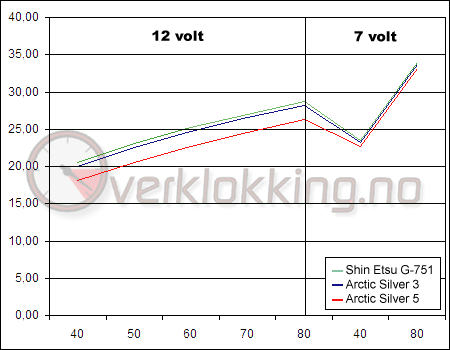
As you can see, it is only marginal difference between
Shin Etsu G-751 and Arctic Silver 3. G-751 is best suited for coolers
with a coarse surface, which the cooler used in this test don't have.
Because of this, the G-751 compound's results are slightly higher
than AS3. This does NOT mean that it is a worse player than AS3 -
if you should have a cooler that has a coarse surface, you might
want to consider G-751 over AS3.
It should not be necessary to tell you that Arctic Silver 5
performs remarkably better than the other participants in this
test. Just take a look at the graph. :)
When we ran the fan on 7 volts the difference between G-751
and AS3 evens out. With a load of 40 watt, the difference is
0.32°C, and at 80 watt load the difference is 0.25°C. Between
AS3 and AS5 the difference at 40 watt is 0.47°C, and at 80 watt
it is 0.59°C.
Conclusion
Arctic Silver 5 is by far the best thermal compound on the market,
at least here in Norway. We don't believe we exaggerate if we
say that Arctic Silver 5 will be the thermal compound most overclockers
will use in the time to come - unless there should come some
other stuff that proves to be better on the market, of course.
:)
Arctic Silver 5 receives two awards: "Recommended" and "Editor's Choice" for
superior performance.
The suggested U.S. retail price for Arctic Silver 5 is $7.95
for the 3.5 gram tube and $19.95 for the 12 gram tube.
Then there is nothing to do but wait until your nearest compound
pusher gets the stuff in stock. :)
 
|

